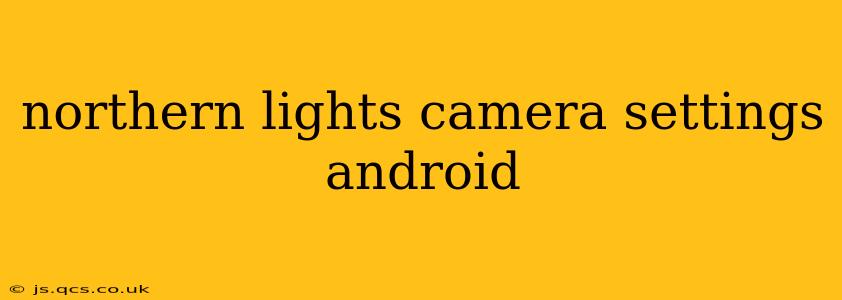Chasing the aurora borealis, also known as the Northern Lights, is a bucket-list experience for many. Capturing its ethereal beauty on camera, however, requires more than just pointing and shooting. This comprehensive guide will walk you through the optimal camera settings on your Android device to help you photograph the magical aurora. We'll cover everything from manual mode settings to app recommendations and post-processing tips, ensuring you get the best possible shots of this breathtaking natural phenomenon.
What Camera Settings Should I Use for the Northern Lights?
The key to capturing stunning Northern Lights photos lies in understanding your camera's capabilities and adjusting the settings to compensate for the low-light conditions. Your Android phone likely won't have the same capabilities as a professional DSLR, but with the right technique, you can still achieve amazing results. Here's a breakdown of crucial settings:
-
Manual Mode: Ditch the automatic mode! For optimal control, switch to your phone's manual mode (often labeled "Pro" or "Manual"). This allows you to adjust key settings individually.
-
ISO: This controls your camera's sensitivity to light. For the Northern Lights, you'll want a high ISO, typically ranging from ISO 3200 to ISO 6400. Going higher than this can introduce significant noise (grain) into your image, but sometimes it's necessary to capture faint auroras. Experiment to find the sweet spot for your phone's camera.
-
Shutter Speed: This determines how long your camera's sensor is exposed to light. A longer shutter speed allows more light to enter, crucial for capturing the faint glow of the aurora. Start with a shutter speed of around 10-30 seconds. You may need to adjust this based on the brightness of the aurora and the level of ambient light. Longer exposures risk blurring from movement (both yours and the aurora itself), so use a tripod.
-
Aperture: This controls the size of the opening in your camera's lens. A wider aperture (smaller f-number like f/1.8 or f/2.0) lets in more light, which is beneficial in low-light conditions. However, many smartphone cameras don't offer manual aperture control.
-
Focus: Manually focus your camera on infinity (∞) or a distant object. Autofocus often struggles in low light, resulting in blurry photos.
-
White Balance: Setting the white balance correctly is vital for accurate color reproduction. Experiment with different white balance settings, such as "Cloudy" or "Fluorescent," to see what works best under the specific lighting conditions. You can also adjust this later in post-processing.
What Apps Can I Use to Photograph the Northern Lights on My Android?
While your phone's built-in camera app can be effective, several dedicated photography apps offer advanced features that can enhance your aurora photography. Many offer manual controls, advanced settings, and post-processing tools. Look for apps with strong reviews and features tailored to astrophotography or low-light photography. Exploring and experimenting with different apps is key to discovering which one works best for your specific phone and shooting style.
How Long Should My Exposure Be for Northern Lights Photography?
The ideal exposure time depends on the intensity of the aurora and the level of ambient light. A good starting point is 10-30 seconds. If the aurora is faint, you might need to increase the exposure time, potentially up to 30 seconds or even longer. However, remember that longer exposures increase the risk of blurring, especially if there's movement in the scene or if your phone isn't perfectly stable on a tripod.
How Do I Avoid Blurred Photos When Taking Pictures of the Northern Lights?
Blurred photos are a common problem in low-light photography. To avoid them:
-
Use a Tripod: A stable tripod is essential for eliminating camera shake during long exposures. Consider a lightweight, portable tripod designed for smartphones.
-
Use a Remote Shutter Release: To minimize camera shake further, use a remote shutter release or your phone's timer function to trigger the photo.
-
Keep Still: Remain perfectly still while the photo is being taken. Even slight movement can cause blurring.
What Are the Best Post-Processing Techniques for Northern Lights Photos?
Post-processing can significantly enhance your Northern Lights photos. Use photo editing apps like Lightroom Mobile or Snapseed to:
-
Adjust Brightness and Contrast: Bring out the details and colors of the aurora.
-
Reduce Noise: Minimize the graininess that often appears in high-ISO images.
-
Adjust White Balance: Fine-tune the colors for a more natural look.
-
Sharpen the Image: Increase the sharpness for clearer details.
By mastering these camera settings and post-processing techniques, you'll dramatically improve your chances of capturing truly breathtaking images of the Northern Lights on your Android phone. Remember, practice makes perfect. The more you experiment, the better you'll become at capturing the magic of the aurora.
